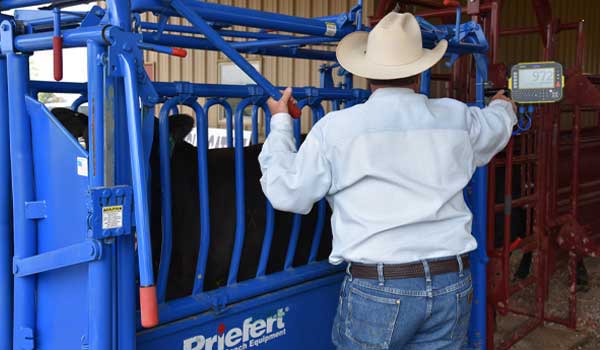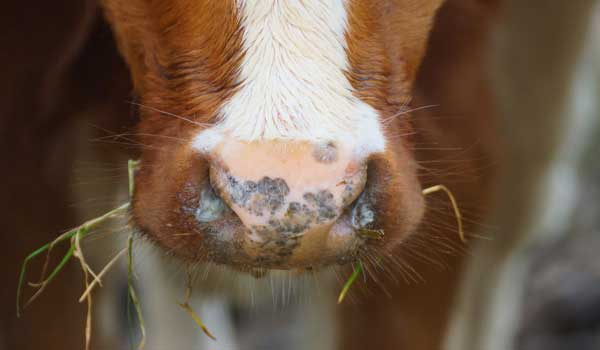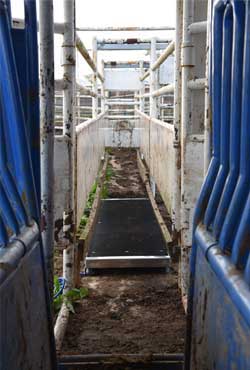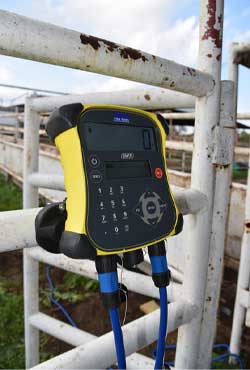Livestock Scales 101: Everything You Need to Know
Leverage livestock scales and monitor weights for improved profit and livestock health

We understand that purchasing livestock scales can be a weighty decision. Continue reading this 101 guide for advice on:
- Monitoring individual animal weights
- Identifying and treating sick livestock
- Increasing profit through weight monitoring
- Understanding electronic identification (EID)
- Selecting livestock scales
Why Weigh Livestock?
While it seems easy enough to eyeball animals to guess individual weights, the human eye can be deceiving. When you have digital cattle scales available, you can expect hefty benefits, such as:
- Improved Reproductive Performance By capturing individual weights more frequently, producers can make more accurate breeding decisions that maximize reproductive performance and profit through timing, calving ease, bull selection, and improved overall calf health.
- Effective Management of Weight Gain Cattlemen can easily monitor rate of weight gain for individual cattle. This allows for tailored feeding programs, more closely tracking input costs, and optimum sale day weights.
- Reduced Treatment Cost and Wasted Medications Medications and parasite control products are dosed to an animal's individual weight. By eliminating the practice of eyeballing weights, producers can maximize the health of livestock with more accurate dosing, while also decreasing treatment waste and cost.
- Quick Identification of Health Issues Weighing livestock more frequently helps producers quickly pinpoint health issues to avoid significant illness and profit loss.

Identifying Sick Animals
Animal care and comfort, as well as an operation's profitability, rely on overall livestock health. How can you tell if herd health has been impacted?
- Reduced weight gain and increased weight loss are the quickest indicators of sickness. In a study reported by Drovers, cattle with subclinical bovine respiratory disease (BRD) had decreased average daily gains up to 0.33 pounds per day. By weighing livestock more frequently, illness can be detected much earlier, helping to quicken treatment and ultimately avoid greater weight loss or worse, potential death loss.
- When impacted by BRD, appetite suppression and feed consumption will decrease some 48 hours before increased body temperature is observed.
- In addition to a gaunt look from appetite suppression, other visual signs of cattle illness can include coughing, labored breathing, eye and nasal discharge, bloody diarrhea, and depression. Should depression set in, you could see drooping head and ears, slower movement, and decreased interest in getting up when approached or keeping up with the herd come feeding time.
- Taking vital signs also can be a useful indicator of illness. Continue reading in this article for more detailed information on assessing vital signs.
Individual Animal Weights Crucial When Treating Livestock
There can be negative consequences when eyeballing body weight, especially when dosing antibiotics and parasite control products,.
Antibiotic doses vary greatly given differences in body weight. When administering antibiotics without capturing accurate, individual body weights, animals may be under-dosed. This decreases antibiotic efficacy and creates a poor treatment response. Overall, this can result in increased treatment and labor costs because of disease relapse. Alternatively, overdosing can increase risk of antibiotic residues and wasted product due to using more antibiotic than needed, which consequently leads to increased treatment costs.
| Three Steps to Capture Weights for Effective Treatments | |
|---|---|
| 1. | Follow effective management practices; discontinue eyeballing. |
| 2. | Record individual weights with a digital scale. |
| 3. | Follow product labels for accurate dosage per individual bodyweight. |
Not Monitoring Weight Gain Could Result in Lost Profit
In visiting with Jason Jones at Datamars, he shared two real-life examples of how cattle operations can experience significant loss by not monitoring weight gain:

Example No. 1: Feeding and forecastingA ranch aimed to market their 700-pound steers at 800 pounds, which should have taken 40 days at a rate of 2.5 pounds average daily gain (ADG). By not closely monitoring weight gain, they achieved only 2.3 ADG, putting the 62 head of steers at 8 pounds less than desired market weight. This resulted in a loss of $545.60/semi-truck load come market time.
Example No. 2: First-conception breedingFor cow/calf operations, first conception is a deal breaker, says Jones. Ideally, a heifer being 60 to 65% of her mature cow weight is optimal for first breeding, thus, tracking weight gain is critical for targeting breeding dates. Every missed cycle puts a heifer (and her calf) back by 21 days. Consider that, on average, calves gain 2.0 pounds per day while on the cow, by missing the first cycle, this could result in a loss of $60 per calf.
Whether you are managing a smaller cattle operation or a large feedlot, by closely monitoring individual body weights, you can help increase profit by:
By keeping a more watchful eye, producers can help ensure their ranch is as profitable as possible for the generations to come.

Understanding Electronic ID/RFID Tags for Cattle and Benefits for Weighing Systems
By combining the many benefits of weighing animals and monitoring individual weights with the power of electronic identification (EID), also referred to as radio frequency identification (RFID ear tags), ranchers can improve their herd's health and productivity for a more profitable operation.
Using EID, ranchers can closely monitor an individual animal's performance, genetics, health treatments, and more through all life stages from calfhood to harvest. Additionally, ranchers can more effectively take advantage of premium marketing opportunities come sale time.
EID cattle tags are available in high-performance half duplex (HDX) or full duplex (FDX) technology. HDX tags provide producers with the greatest read distance and readability through interference. HDX technology is used almost exclusively in dairy applications and is also ideal for permanent weigh systems at packing plants using automated reading systems or walk-through readers. If you have a portable weigh system and closer readability is accessible for your management program, FDX tags are a cost efficient solution, in which data can be captured by using a stick reader or wand at the chute or in an alley way.
Selecting Livestock Scales for Your Operation
As we have uncovered above, there is much to gain when your ranch invests into a weigh system. So, where do you begin? Jason Jones with Datamars recommends asking yourself a few questions before making your purchase to ensure the system is right for your needs.
Do you need the scale to be portable or permanent?
If you have livestock located across different sections, going with a portable platform scale will allow you to easily transport the system to the cattle. When you are weighing livestock by portable installation, simply set up the scale system before the entrance into the squeeze chute to capture weights.
Looking to weigh cattle in the same location they will be processed? If so, your most ideal option will be to have a permanent installation, in which load bars are placed under your squeeze chute and bolted to concrete. Remember, encourages Jones. The more level the load bar is, the more accurate it will be.
Determining whether you will have a portable or permanent installation will drive which load bars you need to complete your system.
Why do you need a weigh scale indicator?
A weigh scale indicator is the physical readout of the animal's weight. There are several models of weigh scale indicators available. Producers can select from basic to more advanced models, which can interface with other technologies, such as EID ear tag readers, allowing producers to automatically sync data into their digital recordkeeping programs. With a more advanced weigh scale indicator, producers can rest easy knowing information is captured correctly and automatically into their computer system.
"You can connect the scale indicators to your computer and click download. By combining data collection with weights and EID technology, you can save a lot of time, Jones said."
How will you incorporate data into management practices?
This is an important factor when deciding which scale indicator model is the best option for you. From the more basic models to the most advanced, producers can use this data for their operation's advantage. Basic models are used to simply track animal weights for health monitoring and marketing purposes. For more advanced management practices, some producers may be using the scale indicator to capture more data such as breed, sex, pregnancy check, or sire/dam. Some indicators also allow producers to group animals together based on various characteristics (a feature available with the XR5000 Bluetooth Indicator).
"The XR5000 is the Cadillac of our line," Jones said. "With that, it has 100 data fields that can be customized. They could preg-check cattle today and enter in how many months bred that cow is, and then the next week, they're weaning calves. The model also programs all the vaccinations they administer and the batch numbers of those vaccines. It even has a dosage calculator."
| Incorporate cattle scales into your management practices to increase efficiency and profit. To construct a complete livestock scale system to put to work on your operation, you will need the following: | |
|---|---|
| 1. | Weigh scale indicator |
| 2. | Platform (if building a portable weigh system) |
| 3. | Squeeze chute (if building a permanent weigh system) |
| 4. | Load bars and load cell |
| 5. | EID reader |
| 6. | EID ear tags |

Advance your animal's health and your ranch's profitability. Shop veterinarian-founded and veterinarian-owned Valley Vet Supply.


